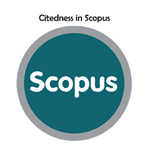Penentuan Kadar Fenol Total Ekstrak Sarang Semut (Myrmecodia Pendands) dengan Metode Ekstraksi yang Berbeda
Abstract
Keywords
Full Text:
PDFReferences
N. Khairiah, I. D. G. P. Prabawa, S. Hamdi, and N. Rahmi, "Aplikasi ekstrak sarang semut sebagai senyawa antimikroba dan antioksidan pada permen karet herbal" Jurnal Riset Industri Hasil Hutan, vol. 11, no. 1, p. 31, 2019.
Susilowati and D. Estiningrum, "Penentuan Golongan Seyawa dan Total Flavonoid dalam Ekstrak Etanol Sarang Semut (Myrmecodia pendens Merr & Perry) secara Spektrofotometri UV-VIS" Jurnal Farmasi (Journal of Pharmacy), vol. 5, no. 1, pp. 19-24, 2016.
F. A. Attamimi, R. Ruslami, and A. M. Maskoen, "Uji Aktivitas Antibakteri Ekstrak Kasar Umbi Sarang Semut (Myrmecodia pendens) Dibanding dengan Klorheksidin terhadap Streptococcus sanguinis" Majalah Kedokteran Bandung, vol. 49, no. 2, pp. 94-101, 2017.
E. Kurniawati and C. Y. Sianturi, "Manfaat Sarang Semut (Myrmecodia pendans) sebagai Terapi Antidiabetes" Majority, vol. 5, no. 3, pp. 38-42, 2016.
I. Rosyadi and B. Hariono, "Potensi Imunologi Serbuk Umbi Tanaman Sarang Semut (Myrmecodia tuberose) Terhadap Tikus Wistar yang Diinduksi Streptozotocin" Jurnal Sain Veteriner, vol. 35, no. 2. p. 159, 2018.
C. E. Dhurhania and A. Novianto, "Uji Kandungan Fenolik Total dan Pengaruhnya terhadap Aktivitas Antioksidan dari Berbagai Bentuk Sediaan Sarang Semut (Myrmecodia pendens)" Jurnal Farmasi Dan Ilmu Kefarmasian Indonesia, vol. 5, no. 2, p. 62, 2019, doi: 10.20473/jfiki.v5i22018.62-68.
N. Ayuchecaria, M. M. A. Saputera, and R. Niah, "Penetapan Kadar Fenolik Total Ekstrak Batang Bajakah Tampala (Spatholobus littoralis Hassk.) MEenggunakan Spektrofotometri UV-Visible" undefined, vol. 3, no. 1, pp. 132-141, May 2020, doi: 10.36387/JIFI.V3I1.478.
Y. Nurul Octaviana and R. Febriyanti, "PENETAPAN KADAR TOTAL FENOL PADA EKSTRAK AKAR BAJAKAH (Spatholobus littoralis Hassk) HASIL PROSES INFUDASI DARI BEBERAPA MEREK YANG BEREDAR DI PASARAN" Jurnal Ilmiah Pharmacy, vol. 10, no. 1, pp. 1-10, Mar. 2023.
S. Y. Kirana, R. Febriyanti, and W. Amananti, "Determination Of Total Flavonoid Content Of Bajakah Tampala And Kalalawit Roots Using The Reflux" Indonesian Journal of Chemical Science and Technology (IJCST), vol. 6, no. 1, pp. 56-64, Feb. 2023.
A. A. Pradana, Kusnadi, and Purgiyanti, "Uji aktivitas antioksidan dari ekstrak etanol biji petai cina (Leucaena leucocephala (Lam) de Wit) dengan metode DPPH" Parapemikir : Jurnal Ilmiah Farmasi, vol. 2, no. 1, 2021.
A. Rizqi, Futikhatul; Kusnadi, M.Pd; Rizki Febriyanti, M.Farm., "Pengaruh Perbedaan Metode Pengeringan terhadap Kadar Total Fenol dari Ekstrak Buah Cabai Rawit (Capsicum frutescens L.)" Politeknik Harapan Bersama Tegal, 2019.
A. Faizatun Isma, R. Febriyanti, P. Studi Farmasi, and P. Harapan Bersama Tegal, "PERBANDINGAN KADAR FENOL TOTAL PADA AKAR BAJAKAH JENIS TAMPALA DAN KALALAWIT DENGAN MENGGUNAKAN SPEKTROFOTOMETRI UV-VIS" Jurnal Insan Cendekia, vol. 10, no. 1, pp. 33-42, Jan. 2023, doi: 10.35874/JIC.V10I1.1113.
A. Khumaira Sari and N. Ayuchecaria Akademi Farmasi ISFI Banjarmasin, "PENETAPAN KADAR FENOLIK TOTAL DAN FLAVONOID TOTAL EKSTRAK BERAS HITAM (Oryza sativa L) DARI KALIMANTAN SELATAN" Jurnal Ilmiah Ibnu Sina, vol. 2, no. 2, pp. 327-335, Oct. 2017.
U. Aulia, "Uji Aktivitas Antioksidan Dan Penentuan Kadar Fenol Total Ekstrak Maserasi Herba Pegagan (CentellaasiaticaL.)" Politeknik Harapan Bersama, 2016.
DEPKES RI, "Materia Medika Indonesia Jilid Vi" Departemen Kesehatan RI, Jakarta, 1995.
H. Suhendy, W. Kusnadiawan, and D. D. Anggita, "PENGARUH METODE MASERASI DAN REFLUKS TERHADAP TOTAL FENOL DAN FLAVONOID DARI DUA VARIETAS UMBI UBI JALAR (Ipomoea batatas L.)" Pharmacosript, vol. 4, no. 1, pp. 89-99, 2021.
R. Febriyanti, M. Putra Mahardika, and R. Ardiyanto, "Skrining fitokimia pada ekstrak hasil proses infundasi akar bajakah" Karya Tulis Ilmiah. Politeknik Harapan Bersama Tegal, 2021.
R. Atika, "Perbandingan Kadar Flavonoid Pada Kulit Bawang Merah (Allium cepa L.) Dan Kulit Bawang Putih(Allium sativum L.) Dengan Metode Spektrofotometri UV-Vis" Politeknik Harapan Bersama Tegal, 2021.
DOI: https://doi.org/10.37311/ijpe.v3i3.23641
Refbacks
- There are currently no refbacks.
Copyright (c) 2024 Diyani Priyanti

Indonesian Journal of Pharmaceutical Education is licensed under a Creative Commons Attribution-NonCommercial-ShareAlike 4.0 International License.



